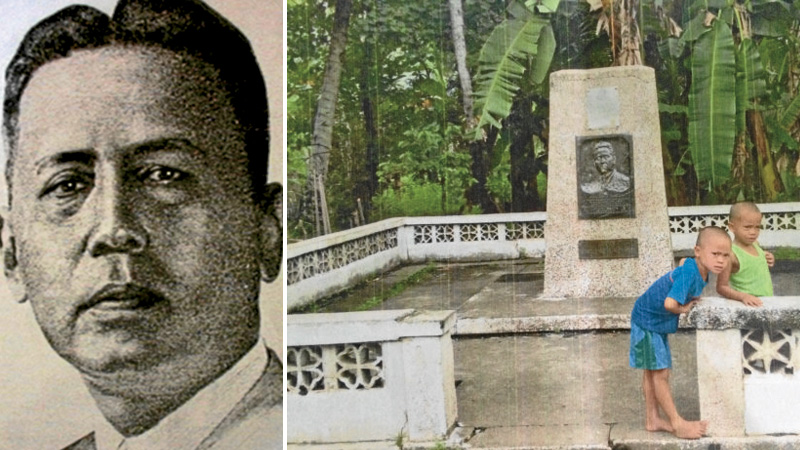Monument fit for a President being readied for Abad Santos

SIMPLE AND NEGLECTED With no grave of Chief Justice Jose Abad Santos (left) to be found, only a “simple and somewhat neglected” monument to the man who served as acting Commonwealth President is found in Malabang, Lanao del Sur province. PHOTO REPRODUCTIONS BY TONETTE T. OREJAS/INQUIRER CENTRAL LUZON
CITY OF SAN FERNANDO—The monument to the late Chief Justice Jose Abad Santos in Malabang town in Lanao del Sur province may be getting a major face-lift to make it fit for the man who served as acting Commonwealth President until the invading Japanese Army executed him in 1942.
Public Works Undersecretary Rafael Yabut has been rallying fellow Kapampangan to support an improved monument to Abad Santos, a native of this Pampanga capital.
Abad Santos died by musketry on May 2, 1942, in Malabang because he refused to collaborate with the Japanese, according to a biography by Ramon C. Aquino. The execution took place less than a month after Bataan and Corregidor fell during the Japanese occupation.
Abad Santos’ grave has not been found since the war ended in 1945.
Yabut, a native of Candaba town in Pampanga, described the Malabang monument as “simple and somewhat neglected.”
“I was helping my brother campaign as a party-list representative when [residents] in Malabang led us to the site,” Yabut told Pampanga Rep. Gloria Macapagal-Arroyo, Gov. Lilia Pineda, local officials and leaders of the Pampanga Chamber of Commerce and Industry at a meeting on Aug. 24.
Three new designs
The monument sits on a private lot, surrounded by trees and banana plants. Freemasons erected the monument in 1959, according to markers at the site. A bronze relief of the martyred Chief Justice was made in 1956. The city government of San Fernando put up its own commemorative marker in Malabang in 2009.
Yabut presented to Pampanga officials three new designs, which could cost from as low as P160,000 to as high as P7.5 million. Pineda has committed to seek out donors.
Abad Santos stayed in the country when President Manuel Quezon and members of the Philippine government were forced to flee to Australia at the start of the Japanese invasion.
First acting President
Quezon’s instructions to Abad Santos, which were contained in a March 17, 1942, letter, read: “In addition to your duties as Chief Justice and acting secretary of finance, agriculture and commerce, I hereby designate you as my delegate with power to act on all matters which involve no change in the fundamental policies of my administration of which you are quite familiar.”
“Abad Santos, in effect, became acting President of the Commonwealth,” Aquino wrote, quoting Associate Justice George Malcolm.
Aquino said Japanese Imperial Army Gen. Masaharu Homma had authorized the execution of Abad Santos.
According to accounts, Abad Santos had asked for 10 minutes to talk to his son, Pepito. “Do not cry, Pepito. Show these people that you are brave. It is a rare opportunity for me to die for our country. Not everybody is given that chance,” he was reported to have said.
Aquino wrote: “Abad Santos had his soiled white suit on. He did not look back … Behind a coconut grove at a turn of the road, Abad Santos disappeared with his executioners. He was shot under a tall coconut tree near a river bank.”
“An intensive search for the place where the hero was executed failed to yield his mortal remains after the war. Pepito did not find the hut and the trees, which were to serve as points of reference in locating the grave. The area where the execution took place had been plowed and planted to root crops,” the author wrote.